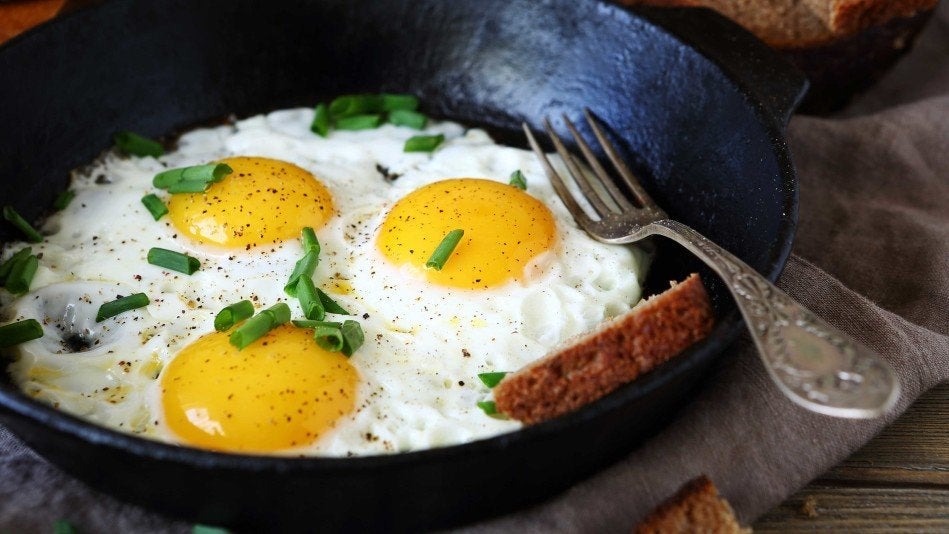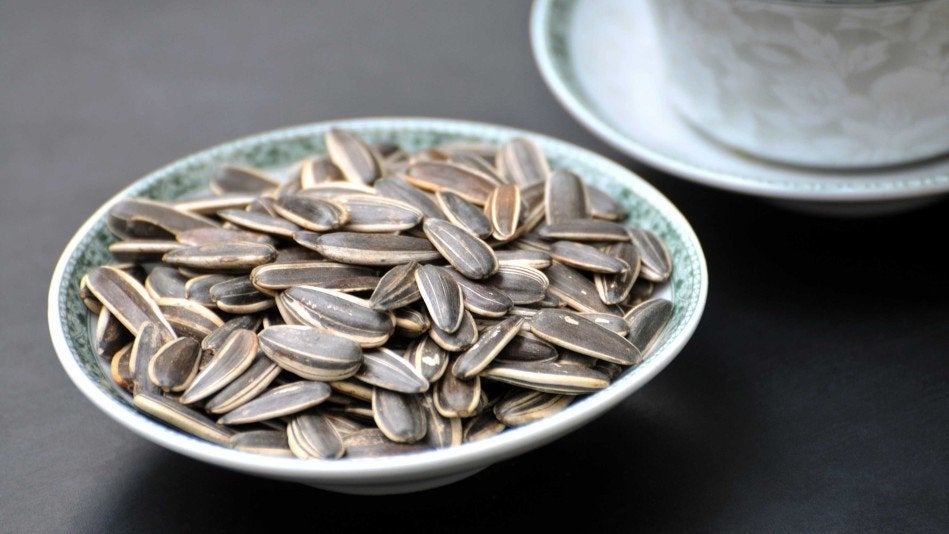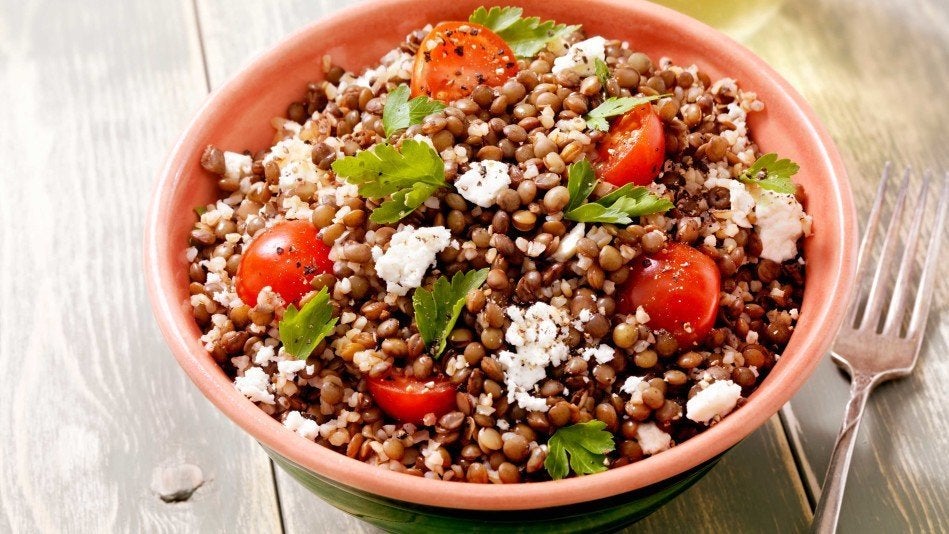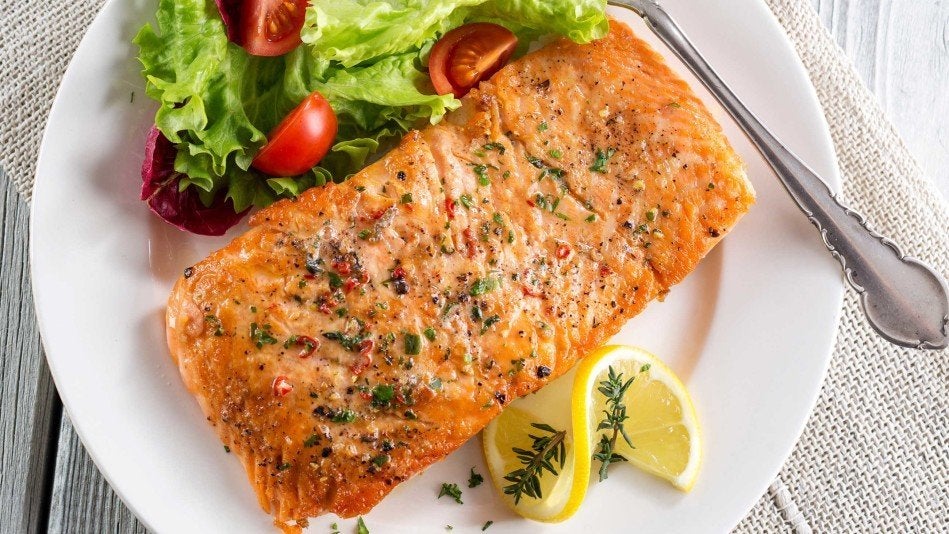In Your 20s

Photo OlhaAfanasievaistockphoto
The Food: Yogurt
Why: For the bone-building calcium. We stop building bone mass around age 30, making your 20s make-or-break (no pun intended) time for gaining bone strength. At this age, you need 1,000 mg of calcium per day to meet your recommended intake–8 ounces of plain low-fat yogurt has 42 percent of that. (Just watch the sugar in any low- or non-fat varieties, as it's often added for taste.)
Where else you can get calcium: You know it's present in other dairy products, like milk and cheese, but there are a lot of non-dairy options too, says Kristin Kirkpatrick, RD, the manager of wellness nutrition services at the Cleveland Clinic's Wellness Institute. Tofu, salmon and leafy greens like kale are all good sources.
The Food: Eggs
Why: Their yolks have vitamin D, which helps your gut absorb all that calcium you're taking in. "You really need both to build up your bones," says Kathryn Sweeney, RD, a dietitian in the department of nutrition at Brigham and Women's Hospital in Boston.
Where else you can get vitamin D: Swordfish has lots of vitamin D, but it's also among the highest-mercury fish, so eat it sparingly. Sardines and canned tuna are high-vitamin-D foods you can eat as often as you like.
Why: For the bone-building calcium. We stop building bone mass around age 30, making your 20s make-or-break (no pun intended) time for gaining bone strength. At this age, you need 1,000 mg of calcium per day to meet your recommended intake–8 ounces of plain low-fat yogurt has 42 percent of that. (Just watch the sugar in any low- or non-fat varieties, as it's often added for taste.)
Where else you can get calcium: You know it's present in other dairy products, like milk and cheese, but there are a lot of non-dairy options too, says Kristin Kirkpatrick, RD, the manager of wellness nutrition services at the Cleveland Clinic's Wellness Institute. Tofu, salmon and leafy greens like kale are all good sources.
The Food: Eggs
Why: Their yolks have vitamin D, which helps your gut absorb all that calcium you're taking in. "You really need both to build up your bones," says Kathryn Sweeney, RD, a dietitian in the department of nutrition at Brigham and Women's Hospital in Boston.
Where else you can get vitamin D: Swordfish has lots of vitamin D, but it's also among the highest-mercury fish, so eat it sparingly. Sardines and canned tuna are high-vitamin-D foods you can eat as often as you like.
In Your 30s

Photo caoyu36istockphoto
The Food: Sunflower Seeds
Why: Arthritis doesn't usually strike until later in life, but the joint damage that can lead to it starts in your 30s, says Kirkpatrick. Seeds like sunflower seeds are packed with healthy omega-3 fatty acids, which can minimize that damage by helping lubricate the joints and lowering inflammation.
Where else you can get healthy fats: Omega-3-rich foods include nuts, other seeds like chia seeds and flaxseeds and, of course, fish like mackerel and anchovies.
The Food: Asparagus
Why: It's high in folate, "which is an important nutrient whether you're pregnant right now or just thinking about having kids," says Jennifer McDaniel, RDN, a spokesperson for the Academy of Nutrition and Dietetics. (Folate is the naturally occurring form of vitamin B9–folic acid is the synthetic version that's often added to fortify foods or used in supplements. There's no evidence that one form is better than the other.) Just four boiled asparagus spears have 22 percent of your daily folate needs. (You need 400 mcg per day normally, but 600 if you're pregnant and 500 if you're breastfeeding.)
Where else you can get folate: It's found in beans, dark, leafy green veggies, avocados and nuts.
Why: Arthritis doesn't usually strike until later in life, but the joint damage that can lead to it starts in your 30s, says Kirkpatrick. Seeds like sunflower seeds are packed with healthy omega-3 fatty acids, which can minimize that damage by helping lubricate the joints and lowering inflammation.
Where else you can get healthy fats: Omega-3-rich foods include nuts, other seeds like chia seeds and flaxseeds and, of course, fish like mackerel and anchovies.
The Food: Asparagus
Why: It's high in folate, "which is an important nutrient whether you're pregnant right now or just thinking about having kids," says Jennifer McDaniel, RDN, a spokesperson for the Academy of Nutrition and Dietetics. (Folate is the naturally occurring form of vitamin B9–folic acid is the synthetic version that's often added to fortify foods or used in supplements. There's no evidence that one form is better than the other.) Just four boiled asparagus spears have 22 percent of your daily folate needs. (You need 400 mcg per day normally, but 600 if you're pregnant and 500 if you're breastfeeding.)
Where else you can get folate: It's found in beans, dark, leafy green veggies, avocados and nuts.
In Your 40s

Photo Lauri Pattersonistockphoto
The Food: Lentils
Why: "Plenty of my patients have slowing metabolisms in their 30s, but it's more common after 40," says Kirkpatrick. "That's when the weight, especially belly fat, starts coming on and it becomes really difficult to take it off." With 15 grams of fiber in a 1 cup serving, lentils are among the highest-fiber foods, and can help you manage your weight in an easy way. In a small 2015 study in the Annals of Internal Medicine, focusing solely on fiber intake (30 grams per day) was nearly as effective for weight loss as a more complicated diet that required followers to eat more fruits, vegetables, fish and lean protein plus cut back on salt, sugar, fat and alcohol.
Where else you can get fiber: Fruits like berries, apples and pears are excellent fiber sources, as are whole-wheat spaghetti, popcorn, beans and vegetables like peas and broccoli.
The Food: Grilled Chicken Breast
Why: Your 40s are when you need to start minding your blood sugar, because your diabetes risk is higher. Lean protein can help limit fluctuations and the insulin your body pumps out in response to blood sugar spikes, says Sweeney. Sixty-three percent of diabetes diagnoses happen between the ages of 40 and 64, according to the most recent national data from the Centers for Disease Control and Prevention, and the National Institutes of Health recommends that you start getting tested for diabetes and pre-diabetes at age 45. (You should talk to your doctor about getting tested earlier if you're overweight or have other risk factors like high blood pressure or cholesterol.) Lean protein can also help counteract the changes in body composition that happen in the years leading up to menopause, says Kirkpatrick, when lean muscle tends to drop while body fat increases.
Where else you can get lean protein: Look for lean ground beef, lean cuts of pork and, for your non-meat options, choose Greek yogurt or eggs.
The Food: Walnuts
Why: They're incredibly high in omega-3 fatty acids. Recommended in your 30s for your joints, in your 40s, these fats may be just as important for your state of mind. There's a link between inflammation and depression, and omega-3s have anti-inflammatory effects on the body. Here's why that matters right now: Women between the ages of 40 and 59 had the highest rates of depression, according to data gathered by the CDC between 2009 and 2012.
Where else you can get omega 3s: You know that fatty fish and seeds are among your best options, but lesser known sources include spinach, tofu and navy beans.
Why: "Plenty of my patients have slowing metabolisms in their 30s, but it's more common after 40," says Kirkpatrick. "That's when the weight, especially belly fat, starts coming on and it becomes really difficult to take it off." With 15 grams of fiber in a 1 cup serving, lentils are among the highest-fiber foods, and can help you manage your weight in an easy way. In a small 2015 study in the Annals of Internal Medicine, focusing solely on fiber intake (30 grams per day) was nearly as effective for weight loss as a more complicated diet that required followers to eat more fruits, vegetables, fish and lean protein plus cut back on salt, sugar, fat and alcohol.
Where else you can get fiber: Fruits like berries, apples and pears are excellent fiber sources, as are whole-wheat spaghetti, popcorn, beans and vegetables like peas and broccoli.
The Food: Grilled Chicken Breast
Why: Your 40s are when you need to start minding your blood sugar, because your diabetes risk is higher. Lean protein can help limit fluctuations and the insulin your body pumps out in response to blood sugar spikes, says Sweeney. Sixty-three percent of diabetes diagnoses happen between the ages of 40 and 64, according to the most recent national data from the Centers for Disease Control and Prevention, and the National Institutes of Health recommends that you start getting tested for diabetes and pre-diabetes at age 45. (You should talk to your doctor about getting tested earlier if you're overweight or have other risk factors like high blood pressure or cholesterol.) Lean protein can also help counteract the changes in body composition that happen in the years leading up to menopause, says Kirkpatrick, when lean muscle tends to drop while body fat increases.
Where else you can get lean protein: Look for lean ground beef, lean cuts of pork and, for your non-meat options, choose Greek yogurt or eggs.
The Food: Walnuts
Why: They're incredibly high in omega-3 fatty acids. Recommended in your 30s for your joints, in your 40s, these fats may be just as important for your state of mind. There's a link between inflammation and depression, and omega-3s have anti-inflammatory effects on the body. Here's why that matters right now: Women between the ages of 40 and 59 had the highest rates of depression, according to data gathered by the CDC between 2009 and 2012.
Where else you can get omega 3s: You know that fatty fish and seeds are among your best options, but lesser known sources include spinach, tofu and navy beans.
Advertisement
In Your 50s

Photo alle12istockphoto
The Food: Cottage Cheese
Why: Your bone density stays pretty steady from 30 to 50, according to the NIH, but in the first few years after menopause, most women experience a sharp drop that puts them at greater risk for osteoporosis. That's why you need an extra 200 mg of calcium per day after age 50, which you can get from many sources, cottage cheese included. At this age, food sources may be a safer bet than calcium supplements–a new study in the Journal of the American Heart Association found that women between the ages of 45 and 84 taking calcium supplements for their bones were more likely to have plaque buildup in their arteries, increasing the risk for heart attacks.
Where else you can get calcium: The usual dairy sources, or you can branch out with foods like white beans, black-eyed peas or seaweed.
The Food: Salmon
Why: After age 55, women's heart-disease risk goes up, partially because estrogen helped protect your body against it, and now that you're through menopause, your estrogen levels are lower. "Fats from fish like salmon can help lower your risk," says McDaniel. Research in the New England Journal of Medicine found that a Mediterranean diet (which emphasizes healthy fats like omega-3s) reduced the risk of serious cardiac events among people at high risk for developing heart disease. Fiber is also important, notes McDaniel, because it can help keep your cholesterol levels down.
Where else you can get healthy fats: Olive oil, nuts, seeds or any of the other omega-3 sources we've already mentioned.
Why: Your bone density stays pretty steady from 30 to 50, according to the NIH, but in the first few years after menopause, most women experience a sharp drop that puts them at greater risk for osteoporosis. That's why you need an extra 200 mg of calcium per day after age 50, which you can get from many sources, cottage cheese included. At this age, food sources may be a safer bet than calcium supplements–a new study in the Journal of the American Heart Association found that women between the ages of 45 and 84 taking calcium supplements for their bones were more likely to have plaque buildup in their arteries, increasing the risk for heart attacks.
Where else you can get calcium: The usual dairy sources, or you can branch out with foods like white beans, black-eyed peas or seaweed.
The Food: Salmon
Why: After age 55, women's heart-disease risk goes up, partially because estrogen helped protect your body against it, and now that you're through menopause, your estrogen levels are lower. "Fats from fish like salmon can help lower your risk," says McDaniel. Research in the New England Journal of Medicine found that a Mediterranean diet (which emphasizes healthy fats like omega-3s) reduced the risk of serious cardiac events among people at high risk for developing heart disease. Fiber is also important, notes McDaniel, because it can help keep your cholesterol levels down.
Where else you can get healthy fats: Olive oil, nuts, seeds or any of the other omega-3 sources we've already mentioned.
In Your 60s And Beyond

Photo Lisovskayaistockphoto
The Food: Shellfish
Why: They're high in vitamin B12. This vitamin is found in lots of animal products, so unless you're vegan, it's rare to be deficient when you're younger. "But B12 needs stomach acid to be absorbed, and we start to lose stomach acid in our 50s and into our 60s," explains Kirkpatrick. Plus, there's a type stomach inflammation that occurs in up to 50 percent of elderly people that can make it hard to absorb B12, which means you'll need to eat more just to get your recommended intake. Finally, B12 is one of three B vitamins that can help lower your levels of an amino acid linked to dementia. (The other two B vitamins are folate and B6.)
Where else you can get B12: Rainbow trout and sockeye salmon, along with milk, yogurt and eggs.
Why: They're high in vitamin B12. This vitamin is found in lots of animal products, so unless you're vegan, it's rare to be deficient when you're younger. "But B12 needs stomach acid to be absorbed, and we start to lose stomach acid in our 50s and into our 60s," explains Kirkpatrick. Plus, there's a type stomach inflammation that occurs in up to 50 percent of elderly people that can make it hard to absorb B12, which means you'll need to eat more just to get your recommended intake. Finally, B12 is one of three B vitamins that can help lower your levels of an amino acid linked to dementia. (The other two B vitamins are folate and B6.)
Where else you can get B12: Rainbow trout and sockeye salmon, along with milk, yogurt and eggs.
